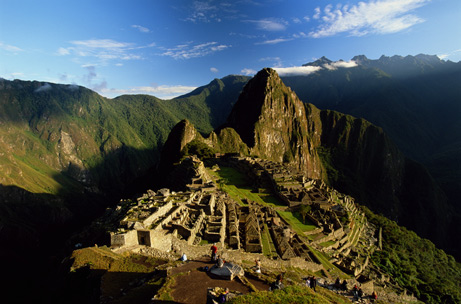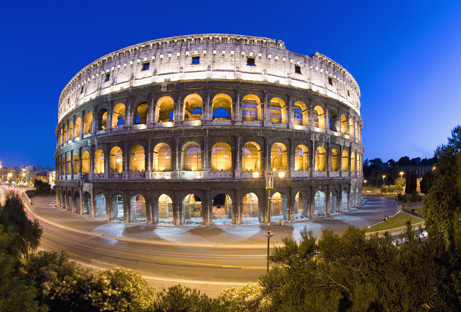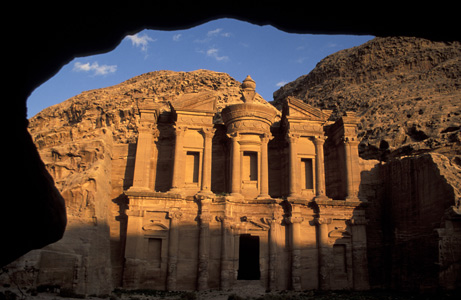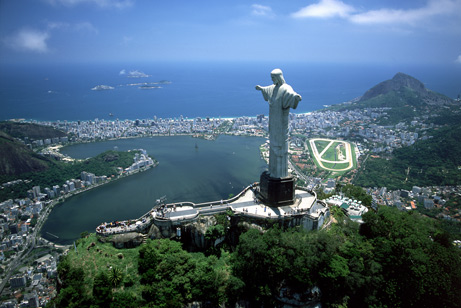There are many majestic ancient sites around the world including statues, temples and monuments. Some were built for royalty or as sacrifices to Gods and others to represent a country’s mighty power and status. Since time immemorial, man has attempted to give expression to the artistic aspect of his mind through the creation of awe-inspiring architectures that is still a source of amazement and wonder for the modern generation. Time and again, humans have referred to some such astounding man-made structures as "wonder of the world". In 2001 the Swiss corporation New7Wonders Foundation began an initiative to choose the New Seven Wonders of the World from a selection of 200 existing monuments for profit. Of the twenty-one nominated creations, seven were chosen on July 7, 2007
1. Taj Mahal, Agra, India
One of the most popular Indian tourist spots and a world attraction, the Taj Mahal is a mausoleum located in Agra, India. Constructed of pure-white marble, this exquisite piece of Islamic arcitecture was created under the orders of the Mughal emperor Shah Jahan who dedicated it to his departed wife, Mumtaz Mahal. The building of this structure began in 1632, and took 22 years to complete. This typical Muslim style under the orders of the Mughal emperor Shah Jahan who dedicated it to his departed wife, Mumtaz Mahal. The domed memorial is flanked by two red sandstone buildings, a mosque on one side and an identical building on another. It contains the sarcophagus of Mumtaz Mahal as well as Shah Jahan. The entire process of construction involved more than 20,000 workers and the marble and semi-precious stones required for the walls were specially fetched from Rajasthan, Persia, Russia, Afghanistan, Tibet, China, and the Indian Ocean. The structure was designed by Muslim architects Abd ul-Karim Ma'mur Khan, Makramat Khan, and Ustad Ahmad Lahauri, who is thought as the main designer.

2. Chichen Itza
The most sacred place in Mayan society, Chichen Itza is where sacred rituals took place to worship gods and bring good fortune to their people and lands. Luckily, no rituals take place here today and the step pyramid can be climbed to the top for views over the surrounding ancient temples and lush green forest.
"Chichen Itza" literally means "At the mouth of the well of the Itza" and consists of numerous splendid stone architectures of which the magnificient Kukulkan Pyramid occupies the centrestage. Known locally as “El Castillo” (the castle), the Kukulkan Pyramid has recently been voted as one of the new seven wonders of the world and is actually a temple dedicated to Kukulkan, the Plumed Serpent. Every year on the fall and spring equinox, during the rising and setting of the sun, the side of the building casts a shadow which appears as a plumed snake along the steps of the structure.

3. Machu Picchu, Cusco,Peru
Located high up in the mountains of Cusco, Machu Picchu was home to the Inca civilisation until it was mysteriously abandoned in the 15th Century. The site, also known as ‘The Lost City’, sits a staggering 2,430 m (7,970 ft) above sea level and is one of the very few places foreign invaders did not locate and still remains intact. The site was rediscovered by U.S. explorer Hiram Bingham in 1911. The architecture has been constructed with polished dry-stone walls and consists of several buildings, primary of which are the Intihuatana, the Temple of the Sun, and the Room of the Three Windows.

4. The Colosseum, Rome,Italy
The Colosseum of Rome is considered to be one of the greatest pieces of Roman architecture. A marvellous specimen of Roman engineering, the Colosseum is an elliptical amphitheatre situated in the centre of Rome. The biggest amphitheatre ever to be built in Rome, it has a capacity of 50,000 spectators and was primarily used for gladiatorial contests, royal speeches and dramatic performances. Built in 70 AD, the Colosseum was used for gory gladiator contests and public spectacles, with crowds of over 50,000 at the peak of its popularity. This imposing feat of Roman engineering has withstood the test of time and although the bare structure can be seen today, it still remains an incredible structure both inside and out.

5. Petra, Jordan
The most popular spot of Jordan, the Petra is an ancient rock city that contains about 800 magnificient rock structures including a mausoleum, a two-storeyed temple, a shrine, a palace, general dwellings and a royal treasury - the "Khazneh el-Farun" - which is the most popular of all the bulidings. This beautiful city was carved out of rocks and inhabited by the Nabataeans more than 500 years before Christ's birth. These industrious Arab people turned it into an important business center and Petra quickly became an important trade route linking the Asian countries with the south Arabian nations Egypt, Syria, Greece and Rome. The city was later under the domination of the Crusaders which ended with the Muslim conquest. But then Petra was completely abandoned and rediscovered only in 1812 by Swiss explorer Johann Ludwig Burckhardt.

6. Christ the Redeemer statue -Rio de Janeiro, Brazil
Built on top of a mountain overlooking Rio de Janeirio, Christ the Redeemer statue of Jesus Christ that weighs 635 tons, stands 98 ft (30 m) wide and 120 ft (38 m) high with its pedestal. Constructed of reinforced concrete and soapstone, this wonderful piece of architecture is located in Rio de Janeiro, Brazil, at the top of the Corcovado mountain (2,300 ft) in the Tijuca Forest National Park overlooking the city. It was in 1921 that the Catholic Circle of Rio proposed for the construction of the statue which recieved acceptance. The statue was designed by Heitor da Silva Costa, a local engineer, and sculpted by French sculptor Paul Landowski. The whole structure took nine years to be completed, from 1922 to 1931, and was opened on October 12, 1931. The cost of construction was $250,000, which came from donations by Brazilian Catholics, collected by the Catholic Circle of Rio.

7. Great Wall of China -China
Spanning an impressive 13,171 miles (21,196 km), the Great Wall of China is officially the longest man-made structure in the world - it would take 18 months to walk along its entire length. Built and re-built over 2,000 years this man-made marvel sees over 4 million visitors each year and is even visible from space!

